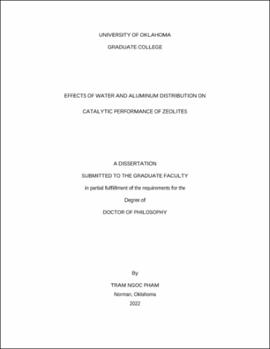| dc.contributor.advisor | Steven, Crossley | |
| dc.contributor.author | Pham, Tram | |
| dc.date.accessioned | 2022-05-13T18:56:37Z | |
| dc.date.available | 2022-05-13T18:56:37Z | |
| dc.date.issued | 2022-05-13 | |
| dc.identifier.uri | https://hdl.handle.net/11244/335755 | |
| dc.description.abstract | Zeolites are used in numerous industrially relevant reactions such as cracking, isomerization, and alkylation. The activity of Brønsted acid sites contained within the microporous zeolite channels might be influenced by the location and resulting local confining environment that stabilizes reaction intermediates and transition states. The presence of active sites nearby and extra-lattice species may modify the environment surrounding active sites, which have been proposed to alter reaction rates significantly. Thus, understanding the effect of these factors on the reactivity of zeolites is essential for the design and synthesis of solid acid catalysts to improve their catalytic performance.
It is well-known that extra-framework Al species generated due to the exposure of zeolites to water at high temperatures can significantly modify the catalytic reactivity of neighboring Brønsted acid sites. Hydrothermal treatment and steaming might lead to the generation of synergistic sites between Brønsted acid sites and extra-framework Al species with high activity for alkane cracking reaction. The generation of these synergistic sites is strongly influenced by the formation, diffusion, and stabilization of extra-framework Al species inside the zeolite pores. Thus, this dissertation aims to reveal the influence of water and other structural properties of zeolites, including the density and the distribution of framework and non-framework Al species in the generation of highly active sites that regulate the catalytic performance of catalysts. In particular, newly developed treatment methods by pulsing water are employed to decouple the rate enhancement due to the generation of highly active sites without the hydrolysis of framework Al sites. The experiment results combined with Density Functional Theory calculations show that cations such as sodium and calcium prefer to exchange with protons associated with highly active sites in zeolites. These cations inhibit the generation of these sites under water treatment. This approach allows quantifying the number of highly active sites and accesses the activation energies for cracking reactions on different types of active sites. Various pre-treatments of catalysts are conducted to modify the cracking rate via enhancement of mobility of extra-framework Al species inside zeolite pores or transformation of these species leading to the generation of new actives sites. Conclusions regarding the generation of highly active sites in MFI zeolite are expanded to other zeolite topologies (FAU, BEA, MOR, MEL, FER, and TON) to understand the impact of confinement and topologies on the reactivity of the catalyst. | en_US |
| dc.language | en | en_US |
| dc.subject | Engineering, Chemical. | en_US |
| dc.subject | Engineering, Materials Science. | en_US |
| dc.subject | Zeolite | en_US |
| dc.subject | Alkane Cracking | en_US |
| dc.title | Effects of water and aluminum distribution on catalytic performance of zeolites | en_US |
| dc.contributor.committeeMember | Daniel, Resasco | |
| dc.contributor.committeeMember | Daniel, Glatzhofer | |
| dc.contributor.committeeMember | Bin, Wang | |
| dc.contributor.committeeMember | Lance, Lobban | |
| dc.date.manuscript | 2022-05-01 | |
| dc.thesis.degree | Ph.D. | en_US |
| ou.group | Gallogly College of Engineering::School of Chemical, Biological and Materials Engineering | en_US |
| shareok.nativefileaccess | restricted | en_US |
